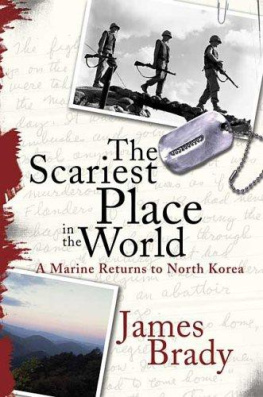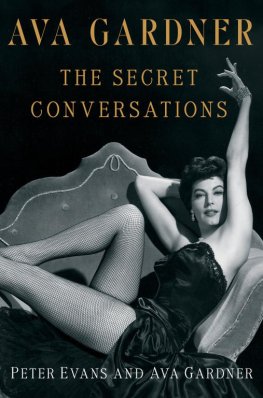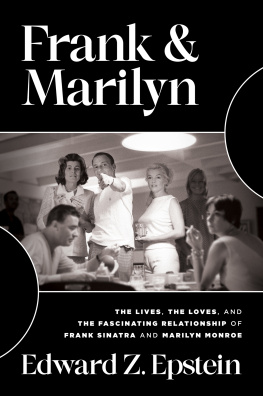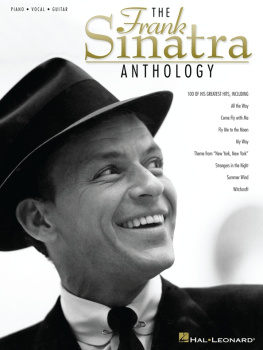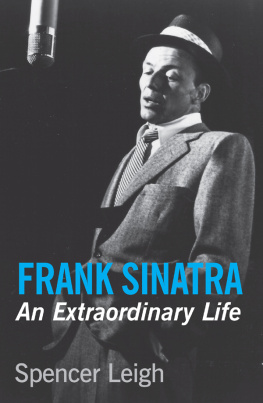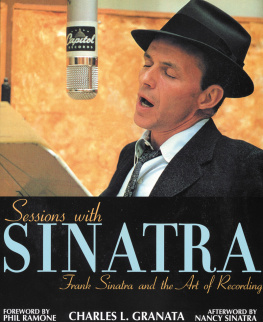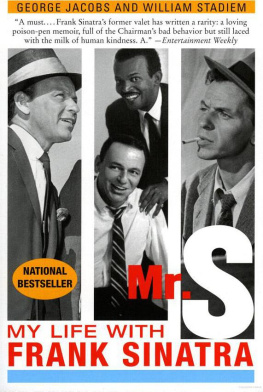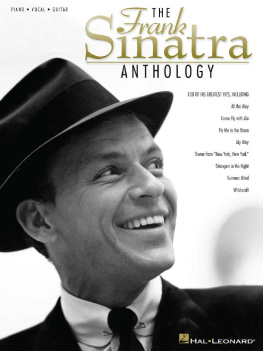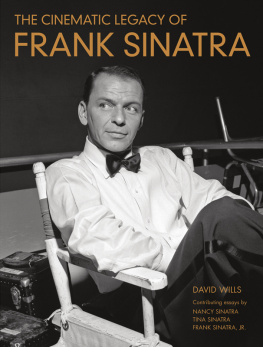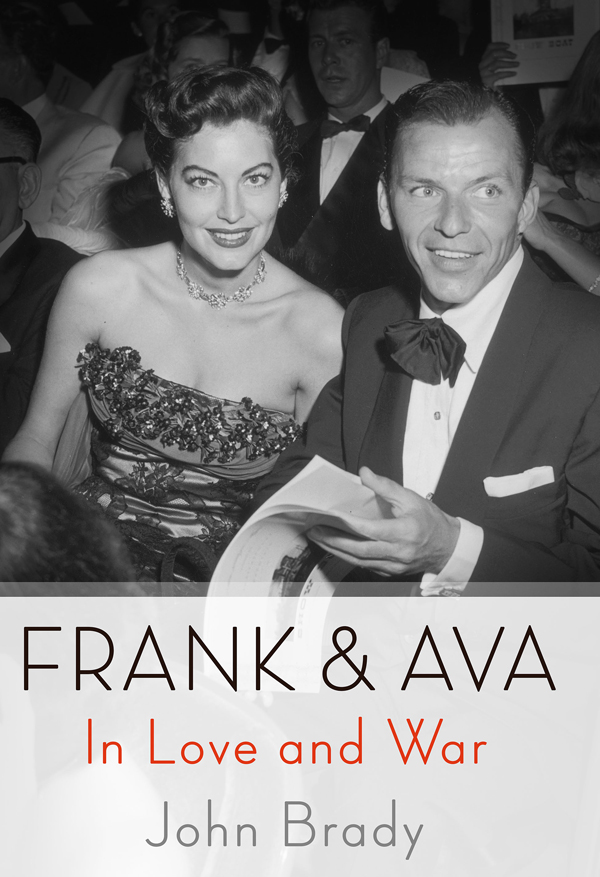Contents
Guide

The author and publisher have provided this e-book to you for your personal use only. You may not make this e-book publicly available in any way. Copyright infringement is against the law. If you believe the copy of this e-book you are reading infringes on the authors copyright, please notify the publisher at: us.macmillanusa.com/piracy.
For TESS & ROSS,
with love
No one ever tells you what its like to love and lose,
How it feels to waken and have breakfast with the blues
Someone tells you later all is fair in love and war,
But no one ever tells you before.
No One Ever Tells You, by Carroll Coates and Hub Atwood Recorded by Frank Sinatra, Los Angeles, April 9, 1956 Capitol Records A Swingin Affair Arrangement by Nelson Riddle
This is a story of love and war that begins in the 1940s, Hollywoods so-called golden age, when celebrity and stardom were different from what they are today. It is a story about a love that was real, not a publicists arrangement, love between two of the biggest stars in the world. It was a time when no paparazzi lurked around cornersuntil these two stars came along.
It was the era of flight, but not jet flight. It was a time when there was no Internet, no television, and all phones had cords. News, if you heard or read it, was usually received the next day, or the day after that, and by then it hardly mattered.
The Depression was winding down, but it had left devastating scars. Poverty and struggle were evident everywhere. Kids signed up for the military, lying about their age, because it was at least something to do. It was work.
For relief, there were radio and the movies. If you wanted to see a movie, you went to a theater, which 95 million people in a nation of 132 million did at least once a week.
There were some exceptions, but movies werent really that good. They didnt have to bethey were the only game in town, and because the studios that produced films also owned the theaters, they could smugly guarantee that none would do badly. Movie making was a billion-dollar business, the sixth-largest industry in the United States.
In Hollywood, the studios were called dream factories, emphasis on factories. Stars were like factory workerscertainly well paid, but not celebrities the way they are today. There was no actors union then. Even the big stars were treated like studio property. In one four-year period at Warner Bros., Humphrey Bogart acted in twenty-nine gangster films. It was work.
Sex was different then. It was a powerful motivatorpeople often married for it, and marriages lasted longer. There was no birth-control pill. For many, there was only abortion, and that was illegal. Families were often large. Only one in six marriages ended in divorce.
In Hollywood, though, the marriage rules were different, and lightly enforced. It was an era when the Caddy was king and nighttime glamour was an evening in a dinner club with a band and dancing. Sex was everywhere. Hollywood was where promiscuity prospered, long before the love-in sixties and the swinging seventies. On location, nothing counted.
Onto this playground came Ava Gardner and Frank Sinatra. In Hollywood, their ambitions and sex drives found their place. Everybody was fucking everybody, said Ava. Maybe it was the war. Frank was married at the time, which made her a home wrecker, and so there was notoriety and shame and all of the things that tabloids and fan magazines quickly learned to exploit.
Their affair became Americas first reality show, with photographers and reporters pursuing Frank and Ava, filing photos and stories from hotels and movie sets around the world.
Their affair led to a tempestuous marriage and a lifelong relationship that was either the best or the worst thing that ever happened to them, depending on how you interpret events. This is the storyfor better and for worseof their remarkable lovers quarrel as they battled their way toward what they hoped would be a Hollywood ending.
When Ava Gardner arrived in Los Angeles in the summer of 1941, all she knew about Hollywood was what she had read in the fan magazines back home in Smithfield, North Carolina, where her mother had taken her to the Howell Theatre, at age nine, to see reigning heartthrob Clark Gable and blonde bombshell Jean Harlow in Red Dust. After three scorching days of travel, Ava stepped off the Super Chief in a cheap summer dress and white wedge sandals, carrying a cardboard suitcase with most of her possessions. The eighteen-year-old beauty did not smoke, did not drink, and was a virgin. She was a stranger in a strange land.
Earlier that summer, in the Manhattan offices of the MGM publicity department, Ava laughed about her chances of fame and fortune before the train started its trip across the continent to Hollywood. Well, if I make it big there, she told the staff, Ill marry the biggest movie star in the world.
Would you like to see the biggest movie star in the world? a publicist asked. He had a photo behind his back, and it wasnt of Clark Gable, as Ava had anticipated. It was of Mickey Rooney.
Six months after this playful exchange, Ava Gardner would indeed marry MGMs biggest moneymaker, Mickey Rooney. When the marriage failed, Ava would marry (and divorce) bandleader Artie Shaw, and have numerous affairs on and off the set, and star in movies with Burt Lancaster, Robert Taylor, and, yes, Clark Gable, in Mogambo, a remake of Red Dust, the movie she had seen with Mama.
In the midst of it all came Frank Sinatra, the most popular singer on the planet, the entertainer of the century, the womanizer of the agesin full pursuit of Ava, a brunette bombshell, the Jean Harlow of her time.
How quickly and easily everything had unfolded. Before the age of thirty, Ava had three brief, wild marriages, and had become a major film star as well as an international sex symbol. It was like one of those breathless stories you might read in a fan magazine.
* * *
Ava Lavinia Gardner was born a farmers daughter on Christmas Eve, 1922, in a house without water or plumbing in a tiny crossroads hamlet called Grabtown, not even on the map, seven miles east of Smithfield, North Carolina, population 5,574. Because of the proximity of her birthday and Christmas, two cakes were baked to celebrate that dayone chocolate, for the family, and a white coconut cake, for baby Ava, both according to mother Mollies recipe. It became a custom that would continue through the years.
Ava was the youngest of five daughters and two sons of Jonas and Mollie Gardner, tobacco sharecroppers who also operated a boardinghouse for teachers. The family was poor. At school, Ava rotated two sweaters, one to wear and the other in the wash.
Jonas Gardner, a lean man of Scots-Irish ancestry, died when Ava was fifteen. He did everything slowly, so deliberately and so well, Ava later remarked. He was her idol. There wasnt an impulsive bone in his body, she said. He used to make us lemonade and I can see him now, sitting at the kitchen table, rubbing the lemons hour after hour so theyd be soft and the juice would literally pour out of them when he finally got around to that part of the operation. Ive never tasted anything like it. No booze was ever so good. Ava grew up playing in the tobacco fields, and assisting her father when the tobacco was aging in barns, where the furnaces had to be stoked to maintain a steady temperature for six or seven days until the leaves were cured. I used to love it, she said. I would stay the night with Daddy, sleeping with him.


